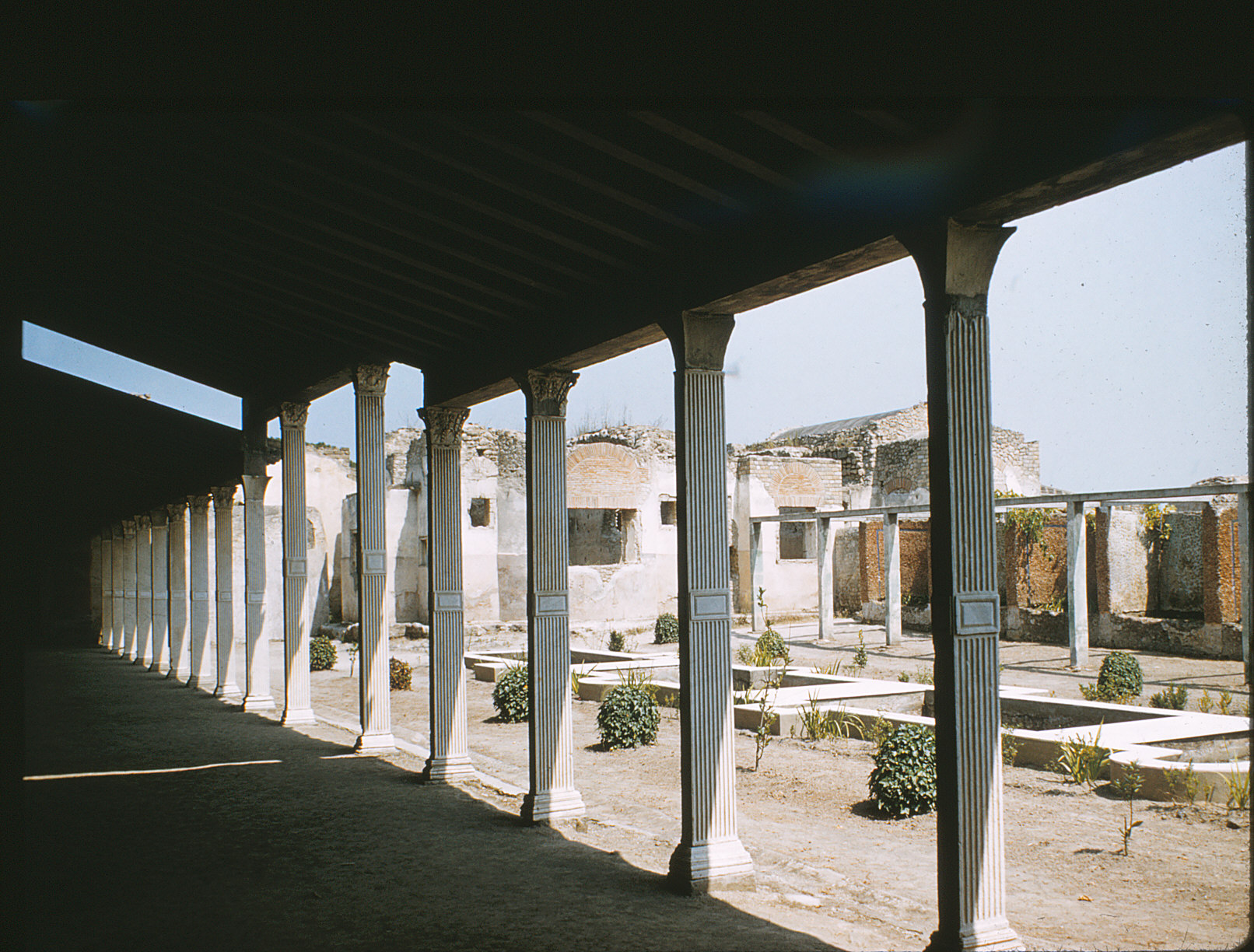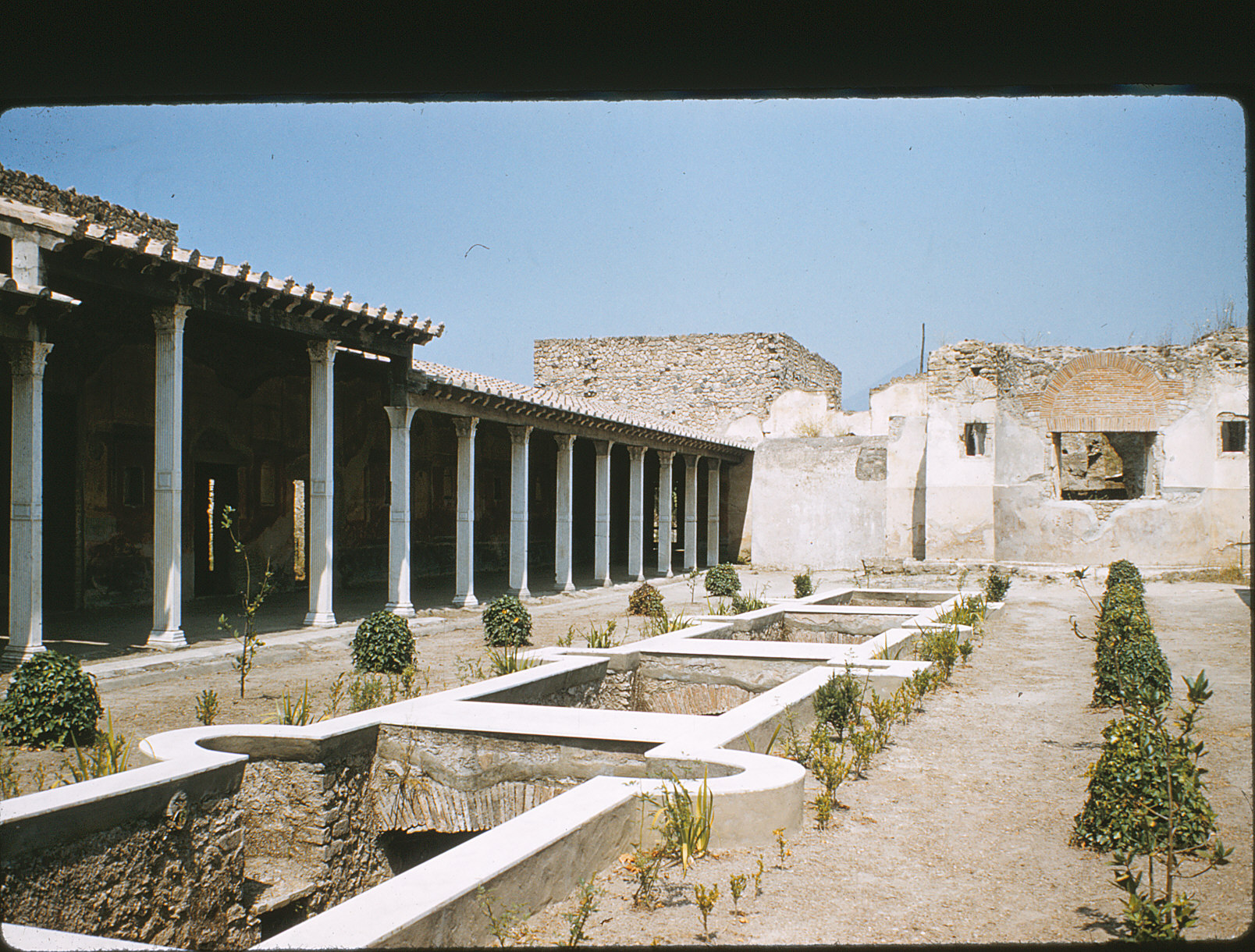II.4 Estate of Julia Felix; Praedia di Giulia Felice
Province
Location
Location Description
An ancient city of Campania destroyed by the volcanic eruption of Mt. Vesuvius in A.D. 79, Pompeii was named as a UNESCO World Heritage Site in 1997.
Sublocation
Insula
Garden
Three separate gardens in the Praedia di Julia Felix.
Keywords
- cisterns (plumbing components)
- jet d'eau
- peristyles (Roman courtyards)
- porticoes
- statuettes (free-standing sculpture)
- triclinia (rooms)
Garden Description
Three separate gardens were located in this property.
A. Garden A (entrance 9) occupies the entire insula and is one of the largest properties in the city. It was originally excavated in 1755-1757, stripped of its works of art and re-buried. In 1951-1952, this garden was re-excavated and restored but not published. Sixteen elegantly carved slender marble pillars support a portico which borders the peristyles (Roman courtyards) garden on the west. An alcove housed a summer triclinium (l. medius, 4.00 m.; l. imus and summus 3.00 m.) with marble faced couches that looked through the portico into the garden. Between the couches a niche supplied water that ran down small marble steps to a hole at the bottom. The water re-surfaced as a jet in the middle of the triclinium. A vine covered arbor stretched along the south and east side of the garden and beyond it in bays on the east wall were raised planting beds, alternating semicircular and square. These were covered with pumice and decorated with a band of Egyptian blue around the sides and top, the middle bay having four bands of Egyptian blue. The room to the south of the triclinium had a garden representation (0.185 x 0.42 m) on the north part of the west wall on the red middle zone.
Four fish pools connected to form a long channel (euripus) down the center of the garden. The little marble bridges that crossed the channel and covered alcoves at the bottom of the pools provided shelter for the fish and eels.
A number of statuettes were found during the two excavations of this site. More recently the pieces that were found are as follows: A marble satyr (0.475 m. preserved height; Pompeii inv. no. 8856) located at the north end of the pool, a seated terra-cotta figure of Pittacus of Mitylene (0.65 m high; Pompeii inv. no. 2181-4) found at the edge of the pool, a small marble fountain statuette of a sea crab in a shell (0.19 m wide; Pompeii inv. no. 1073/54). During the earlier excavation some of the items found were as follows: a satyr child (0.46 m high; Muz. Naz. inv. no. 6108), a nude youth holding grapes in his right hand and a goose in his left (0.76 m high; Muz. Naz. inv. no. 6342), a faun (Muz. Naz. inv. no. 6343), an old man covered with a cloth (0.49 m. high), a bird with a lizard in its beak (0.32 m. high), a marble mask of a smiling youth on a small column (0.54 m. high), and a marble relief (0.36m. long x 0.11 m. high) of an old man seated of a bench, perhaps this was a pinax. The heads of twelve marble herms, (one woman, one old man, three bearded men) were reported by PAH, but the post of only one is mentioned and only the feet of the thirteenth herm was found. A terracotta group of Caritas Romana was found in many pieces as well as multiple fragments of other terra-cotta statuettes which had been in the eleven niches in the peristyles (Roman courtyards) portico. Chambalu believed the herms stood between these niches.
B. An outdoor swimming pool (8.50 x 4.50 m; 1.50 m deep) was located in the garden area in the northeast part of the insula. There were steps into the pool on the north and south sides, and an entrance (8) into the area from the side street.
C. A walled rustic garden close to entrance 8 had been planted and at the time of the excavation; rectangular planting bed contours were evident here. This included tree root cavities were noted around the perimeter of each bed and four rectangular water basins (one of which was double), and a cistern opening.
Plans

view form the portico

detail of the jet.
Dates
Partially excavated 1754 to 1757, 1933 to 1935, fully re-excavated 1951.
Bibliography
- Annali Dell'instituto Di Correspondenza Archeologica, 1830, p.50 worldcat
- Bonucci, Da Carlo. 2018. Pompei Descritta Da Carlo Bonucc, p.219 worldcat
- Bragantini, Irene. 1981. Pitture E Pavimenti Di Pompei. Roma: Ministero per i beni culturali e ambientali, Istituto centrale per il catalogo e la documentazione, 1981. 1:238 worldcat
- Chambalu, August. 1895. Die weiderverschüttete Besitzung der Julia Felix beim Amphitheater in Pompeji, pp. 14-15 and plan of Weber (1757) after p. 20 worldcat
- Della Corte, M. 1958. Notizie degli scavi antichita, p. 125, no. 238 (Pittakos inscription); worldcat
- Dwyer, Eugene J. 1981. Pompeian Oscilla Collections: (pls. 80-130) Mainz: Verlag Philipp von Zabern, p. 279, no. 81 worldcat
- Rakob, F. 1964. *Ein Grottentriklinium in Pompeji,*RM (1964), pp. 182-194;worldcat
- Döhl, H. 1976. Plastik aus Pompeji, tesi di libera d tingen, pp. 8-10.
- Idem, Pompeii (Novara), p. 111 worldcat
- Idem, Pomp. Sculpture, pp. 67, 128, and figs. 197, 212.
- Jashemski, Wilhelmina F. 1979. The Gardens of Pompeii, Herculaneum, and the Villas Destroyed by Vesuvius, New Rochelle: Aristide D. Caratzas, 1:48, p. 110 and figs. 81 on p. 47, 82 on p. 48, 83 (marble statue at north end of pool), figs. 84 (Pittacus), and 85 (sea-crab in shell) on p. 49. worldcat
- Jashemski, Wilhelmina F. 1993. The Gardens of Pompeii: Herculaneum and the Villas Destroyed by Vesuvius. New Rochelle, NY: Caratzas, pp. 86-88, 396 worldcat
- Kapossy, Balázs. 1969. Brunnenfiguren Der Hellenistischen Und Römischen Zeit. Zürich, pp 46, 50 worldcat
- Lorenz, Thuri. 1965. Galerien Von Griechischen Philosophen Und Dichterbildnissen Bei Den Römern. Mainz: Verlag Ph. von Zabern, p. 39 worldcat
- Maiuri, A. 1961. I giardini, Le Vie d’Italia, no.9, p. 1139; worldcat
- Maiuri, A. 1952. Statuette fittilli di Pittaco di Mitilene, Archeologia Classica, 4: pp. 55-59; worldcat
- Maiuri, A. Pompei ed Ercolano:Fra case ed abitanti, pp. 74-75; worldcat
- Pompeianarum Antiquitatum Historia. vol. 1, pt. 1, pp. 13, 15, 16, 18-19, 21, 28-31, 34, 37, 39 (Apr. 13, 1755-Mar. 6, 1756), and pt. 2 pp. 98, 101; worlcat
- Richter, Greek Portraits, 3:34 and fig. 134; worlcat
- Richter, G. M. A. 1960. Portraits of the Greeks, 1:89a. Latomus. worlcat
- Rohden, Hermann. 1880. Die Terracotten Von Pompeji. Stuttgart, pp. 24, 47-48, 53, 57, 62 and plates 35.3, 36, 41.4, 47; worldcat
- Ricotti, Salsa Prina. 1987. The Importance of Water in Roman Open Air Tricliniums, In Ancient Roman Villa Gardens, Dumbarton Oaks Colloquium on the History of Landscape Architecture, 10, Dumbarton Oaks, pp. 172-173; worlcat
- Sear, Frank B. 1977. Roman Wall and Vault Mosaics. Heidelberg: F.H. Kerle, p.94 worlcat
- Zahn, Wilhelm. 1828. Die Schönsten Ornamente Und Merkwürdigsten Gemälde Aus Pompeji, Herkulanum Und Stabiae, 2, pl.100 (plan) worldcat
Pleiades ID
Contributor
Wilhelmina Jashemski (https://lib.guides.umd.edu/c.php?g=326514&p=2193250)
Publication date
21 Apr 2021